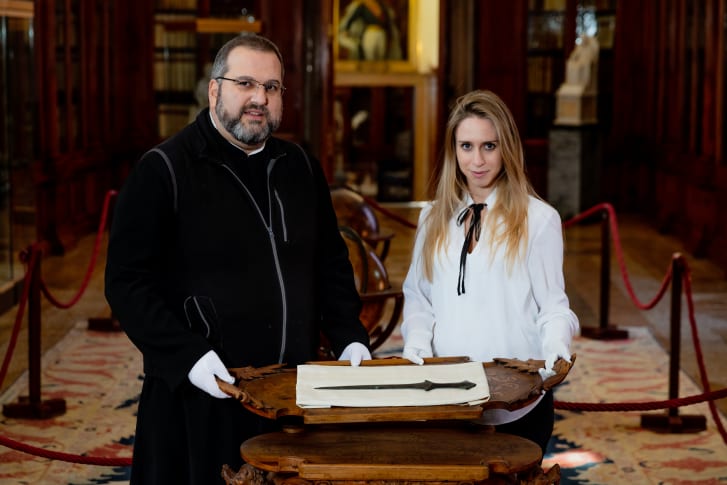Student Discovers 5000-Year-Old Sword in a Monastery in Venice

The Armenian St. Lazarus Monastery sits on its own small island in the Venice Lagoon. The island acted as a leper colony from the 12th to the 16th centuries. A
fter that, it sat abandoned until 1717 when the Venetian government gave the island to Mekhitar, an Armenian monk who fled to Venice to escape being persecuted by the Turkish. He used it to found an Armenian monastery, naming it after the patron saint of lepers.
Today, the monastery is still home to a small population of monks, seminarians, and some Armenian students who are there to learn about Italian culture. The grounds hold not only extensive gardens, but also a museum holding a variety of ancient artifacts.

According to a recent CNN reports, at least one of the artifacts in the monastery’s collection is even older than the friars thought.
Vittoria Dall’Armellina, an archaeologist from Ca’Foscari University, visited the museum when she was still a doctoral student back in 2017. She was taking a guided tour when a metal sword in one of the last displays drew her eye.
The sword was approximately 17 inches long and resembled those she had seen during her studies of Bronze Age weaponry.
The sword was labeled as being from the medieval period but she believed it to be much older than that. It had not been recorded as part of the museum’s collection of Near East artifacts, which may explain how it ended up displayed with the medieval items.
Dall’Aremellina’s studies were focused on the evolution of swords in the Ancient Near East, and as soon as she saw this particular piece, she knew it had been miscataloged.
It looked a lot like some weapons that had been found in the Royal Palace of Arslantepe and were believed to be some of the oldest swords in the world.
What followed was two years of research and study. Not only was she proved to be correct in her first impression, but the weapon was shown to be one of the oldest weapons of its type ever discovered. In fact, it is around 5,000 years old.
In collaboration with Ivana Angelini, a professor at the University of Padua, she and her research team conducted a study and chemical analysis to determine the sword’s exact composition. It was made from arsenical bronze.
The alloy of copper and arsenic was used at the end of the 4th century BC and the beginning of the 3rd century BC, before the use of bronze became the new standard.
The end result of her research showed that the sword at St. Lazarus not only resembled the swords from the palace, but it had been made around the same time – 3,000 BC.
It was during that era that a new noble class was on the rise in regions such as the Caucasus, Anatolia, and the Aegean. Researchers believe that those were also the areas where swords began to be forged to be weapons as well as symbols of the new class of warriors. When those warriors died, they would be buried with various symbols of their rank and might, including their swords.
One of the monks at St. Lazarus, an archival researcher named Father Serafino Jamourlian, helped confirm the provenance of the ancient weapon. He was able to say that the sword came to the monastery as part of a shipment of artifacts from a civil engineer in the Ottoman Empire.
Yervant Khorasandjin, the engineer, had studied at a school run by the Mekhitarist order in the late 1800s. That school was run by Father Ghevont Alishan, who later moved to St. Lazarus, staying there until his death in 1901. Documentation at the monastery showed that the sword had been sent to the monastery from Turkey between August and September of 1886.
An Incredible Artifacts From Lost Viking ‘highway’ Revealed by Melting Ice
Since the news about the sword’s age has come out, potential visitors to the monastery have been expressing interest in coming to see it, but the museum is currently closed because of the coronavirus pandemic.
